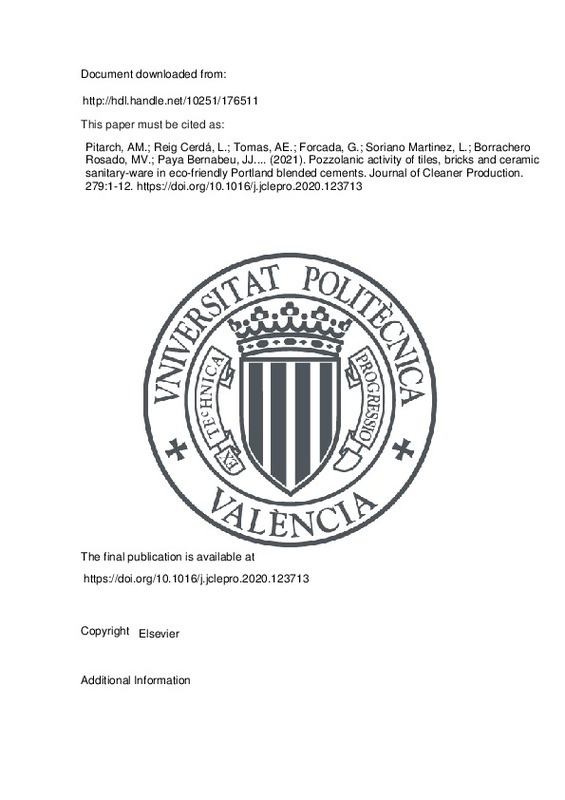JavaScript is disabled for your browser. Some features of this site may not work without it.
Buscar en RiuNet
Listar
Mi cuenta
Estadísticas
Ayuda RiuNet
Admin. UPV
Pozzolanic activity of tiles, bricks and ceramic sanitary-ware in eco-friendly Portland blended cements
Mostrar el registro sencillo del ítem
Ficheros en el ítem
| dc.contributor.author | Pitarch, A. M.
|
es_ES |
| dc.contributor.author | Reig Cerdá, Lucía
|
es_ES |
| dc.contributor.author | Tomas, A. E.
|
es_ES |
| dc.contributor.author | Forcada, G.
|
es_ES |
| dc.contributor.author | Soriano Martinez, Lourdes
|
es_ES |
| dc.contributor.author | Borrachero Rosado, María Victoria
|
es_ES |
| dc.contributor.author | Paya Bernabeu, Jorge Juan
|
es_ES |
| dc.contributor.author | Monzó Balbuena, José Mª
|
es_ES |
| dc.date.accessioned | 2021-11-05T14:12:34Z | |
| dc.date.available | 2021-11-05T14:12:34Z | |
| dc.date.issued | 2021-01-10 | es_ES |
| dc.identifier.issn | 0959-6526 | es_ES |
| dc.identifier.uri | http://hdl.handle.net/10251/176511 | |
| dc.description.abstract | [EN] Reusing ceramic waste as a pozzolanic admixture may offer environmental benefits as it allows the reduction in the consumption of natural resources and energy, and the reduction of CO2 emissions associated with Portland cement (PC) production, while valorising waste materials with a long biodegradation period. This paper assessed the pozzolanic activity of three different ceramic waste types: red clay bricks (RCB), ceramic tiles (TCW) and ceramic sanitary-ware (CSW). After adapting their particle size by crushing and milling, each was used to replace 0 to 50 wt% PC (CEM I 42.5 R type). The milled powders were characterised by laser diffraction, field emission scanning electron microscopy (FESEM), X-ray fluorescence (XRF) and X-ray diffraction (XRD), and consistency and setting time tests were used to investigate the fresh behaviour of the ceramic waste/PC blended pastes. A basic sustainability analysis was performed, and the pozzolanic activity of RCB, TCW and CSW was assessed by compressive strength tests (performed in mortars cured at room temperature from 3 to 365 days) and microstructural analyses (thermogravimetry, XRD and FESEM performed in the pastes cured at 20 °C for 28 and 90 days). The pozzolanic reaction of these waste materials improved with curing time, and all the mortars prepared with up to 25 wt% RCB, TCW or CSW met the mechanical requirements set out for coal fly ashes, whatever the ceramic waste type used. Among them, these results open up the possibility of partially replacing PC with the closest available ceramic waste, which would reduce the CO2 emissions and economic cost deriving from transporting waste. | es_ES |
| dc.description.sponsorship | The authors are grateful to the Spanish Ceramic Tile Manufacturers' Association (ASCER) for supporting this study through the collaboration agreement with Universitat Jaume I (Aula Ceramica). They also thank the Electron Microscopy Service of the Universitat Politecnica de Valencia and the Central Service for Scientific Instrumentation of the Universitat Jaume I of Castellon for helping with the microstructural characterisation tests. | es_ES |
| dc.language | Inglés | es_ES |
| dc.publisher | Elsevier | es_ES |
| dc.relation.ispartof | Journal of Cleaner Production | es_ES |
| dc.rights | Reconocimiento - No comercial - Sin obra derivada (by-nc-nd) | es_ES |
| dc.subject | Portland cement | es_ES |
| dc.subject | Ceramic waste | es_ES |
| dc.subject | Waste management | es_ES |
| dc.subject | Pozzolanic activity | es_ES |
| dc.subject | Compressive strength | es_ES |
| dc.subject.classification | CONSTRUCCIONES ARQUITECTONICAS | es_ES |
| dc.subject.classification | INGENIERIA DE LA CONSTRUCCION | es_ES |
| dc.title | Pozzolanic activity of tiles, bricks and ceramic sanitary-ware in eco-friendly Portland blended cements | es_ES |
| dc.type | Artículo | es_ES |
| dc.identifier.doi | 10.1016/j.jclepro.2020.123713 | es_ES |
| dc.rights.accessRights | Abierto | es_ES |
| dc.contributor.affiliation | Universitat Politècnica de València. Departamento de Ingeniería de la Construcción y de Proyectos de Ingeniería Civil - Departament d'Enginyeria de la Construcció i de Projectes d'Enginyeria Civil | es_ES |
| dc.contributor.affiliation | Universitat Politècnica de València. Departamento de Construcciones Arquitectónicas - Departament de Construccions Arquitectòniques | es_ES |
| dc.description.bibliographicCitation | Pitarch, AM.; Reig Cerdá, L.; Tomas, AE.; Forcada, G.; Soriano Martinez, L.; Borrachero Rosado, MV.; Paya Bernabeu, JJ.... (2021). Pozzolanic activity of tiles, bricks and ceramic sanitary-ware in eco-friendly Portland blended cements. Journal of Cleaner Production. 279:1-12. https://doi.org/10.1016/j.jclepro.2020.123713 | es_ES |
| dc.description.accrualMethod | S | es_ES |
| dc.relation.publisherversion | https://doi.org/10.1016/j.jclepro.2020.123713 | es_ES |
| dc.description.upvformatpinicio | 1 | es_ES |
| dc.description.upvformatpfin | 12 | es_ES |
| dc.type.version | info:eu-repo/semantics/publishedVersion | es_ES |
| dc.description.volume | 279 | es_ES |
| dc.relation.pasarela | S\430888 | es_ES |
| dc.contributor.funder | Universitat Jaume I | es_ES |
| dc.contributor.funder | Asociación Española de Fabricantes de Azulejos y Pavimentos Cerámicos | es_ES |
| dc.subject.ods | 11.- Conseguir que las ciudades y los asentamientos humanos sean inclusivos, seguros, resilientes y sostenibles | es_ES |







![[Cerrado]](/themes/UPV/images/candado.png)

